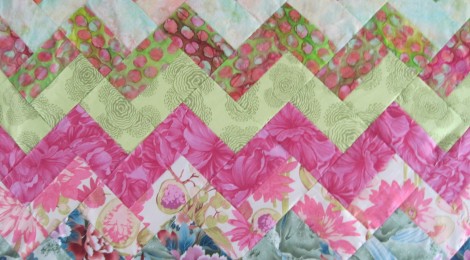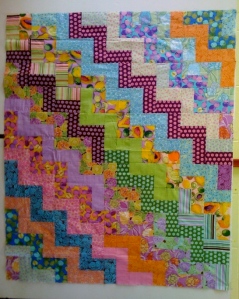
The rectangular atom
Okay, we’re finally onto the next amazing quilt atom, and I consider that to be the rectangle. If you think about it, rectangles are just like long drawn-out squares. And like the square, the rectangle is tremendously useful for piecing. Not only are rectangles used to build blocks, but they’re also used for sashing, those long framing strips that surround a block and connect it to the next one. As quiltmakers we tend to divide the rectangle into imaginary squares — a grid if you will — and we think of each rectangle as being ‘n’ many grid units long. [remember that annoying habit of your algebra teacher of substituting letters for numbers? Well here it is again. You thought you could run. You thought you could hide. But it’s all right, really. It’s safe to come out. Just fill in your favorite number for ‘n’ as an example.]
If you stand next to an experienced quiltmaker at a quilt show, and you catch them staring for a long time at the quilt, the chances are that they aren’t dreaming up dinner for the evening or even computing their yearly taxes, but instead are mentally dividing up the block — and its individual pieces — into grid units. In fact they have to first identify the block — the most basic repeating unit of the quilt — and then figure out its constituent parts. It’s exhausting. And sometimes it requires leaving your mouth open. I know. I’ve been told that a lot of bugs could fly into my open mouth when I’m staring at a particularly breathtaking quilt. (and yes I’ve been told to close my mouth please by passersby concerned by how much of my diet would be made up of said bugs)
Learning how to divide (mentally if nothing else) pieces and blocks into grid units is an essential part of quiltmaking. Because much like a Japanese dictionary for its written language, a block encyclopedia is organized by level of complexity. The most simple blocks are first — a four grid or four-patch block, just two grid units by two grid units — and continue on with nine-patch (three by three), 16-patch (which often can be simplified to a four-patch), and 25-patch. You can use any quadrille graph paper (or any you prefer) to draw blocks on, and simply decide later how big each grid is going to be in your quilt.
So typically we start to see rectangles appear in four-patch patterns, because the first rectangle we can build is two grid units long. And of course beyond that we can make rectangles that are three, four, or five units long, or longer, if need be for a particular block.
One of the simplest uses of the rectangle is the rail fence block. It’s just two — or more — rectangles stacked on top of each other to form a square. And if that square is tipped and tilted as it’s laid out with its neighbors — it becomes a diagonal zig zag line. Yay! Diagonals without having to cut or sew triangles! Genius!
Here’s a great little scrappy quilt made from little (two color) rail fence blocks:
If you keep one of the colors in the ‘fences’ the same throughout you get a bit more regular zig zag:
Another way rail fences are often laid out are in a pattern that looks like plain or basket weave:
There’s lots more layouts and instructions for basic rail fence quilts on the generations quilt pattern site — check it out!



awesome post! it’s funny because I’ve done the whole “staring with mouth open” trying to figure out how the quilt is put together, but it makes more sense now, what I should actually be looking for! thanks!
Ciekawy artykuł, wiele wnoszący. Czekam na więcej